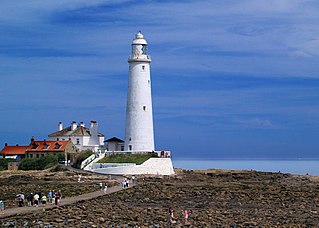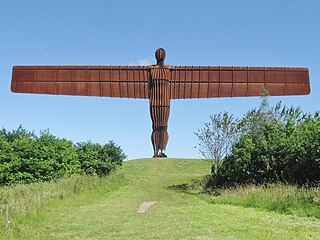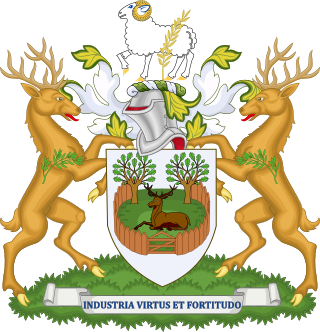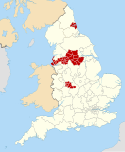
The Borough of Runnymede is a local government district with borough status in Surrey, England. Its council is based in Addlestone and the borough also includes the towns of Chertsey and Egham. The borough is named after Runnymede, a water meadow on the banks of the River Thames near Egham, which is connected with the sealing of Magna Carta by King John in 1215.

North Tyneside is a metropolitan borough in the metropolitan county of Tyne and Wear, England. It forms part of the greater Tyneside conurbation. North Tyneside Council is headquartered at Cobalt Park, Wallsend.

The Borough of Broxbourne is a local government district with borough status in Hertfordshire, England. Its council is based in Cheshunt. Other settlements in the borough include Broxbourne, Hoddesdon and Waltham Cross. The eastern boundary of the district is the River Lea. The borough covers 20 square miles (52 km2) in south east Hertfordshire, and had an estimated population of 99,000 in 2021.

The Borough of Fareham is a local government district with borough status in Hampshire, England. Its council is based in Fareham. Other places within the borough include Portchester, Hill Head, Sarisbury, Stubbington, Titchfield and Warsash. The borough covers much of the semi-urban area between the cities of Southampton and Portsmouth, and is part of the South Hampshire conurbation. The neighbouring districts are Eastleigh, Winchester, Portsmouth and Gosport. The district's southern boundary is the coast of the Solent.

Dudley Metropolitan Borough Council is the local authority for Dudley metropolitan borough. It is more commonly known as Dudley Council or Dudley MBC.

Sunderland, also known as the City of Sunderland, is a metropolitan borough with city status in the metropolitan county of Tyne and Wear, England. It is named after its largest settlement, Sunderland, spanning a far larger area, including nearby towns including Washington, Hetton-le-Hole and Houghton-le-Spring, as well as the surrounding villages and hamlets. The district also forms a large majority of Wearside which includes Chester-le-Street in County Durham.

The Metropolitan Borough of Gateshead is a metropolitan borough in the metropolitan county of Tyne and Wear, England. It includes Gateshead, Rowlands Gill, Whickham, Blaydon, Ryton, Felling, Birtley, Pelaw, Dunston and Low Fell. The borough forms part of the Tyneside conurbation, centred on Newcastle upon Tyne. At the 2021 census, the borough had a population of 196,154.

Newcastle City Council is the local authority for Newcastle upon Tyne, a metropolitan borough with city status in the ceremonial county of Tyne and Wear in North East England. The council consists of 78 councillors, three for each of the 26 wards in the city. It has been under Labour majority control since 2011. The council is a constituent member of the North East Mayoral Combined Authority.
Sunderland City Council elections are generally held three years out of every four, with a third of the council being elected each time. Sunderland City Council is the local authority for the metropolitan borough of the City of Sunderland in Tyne and Wear, England. Since the last boundary changes in 2004, 75 councillors have been elected from 25 wards.

Middlesbrough Council, also known as Middlesbrough Borough Council, is the local authority for Middlesbrough, in the ceremonial county of North Yorkshire, England. Since 1996 it has been a unitary authority, providing both district-level and county-level services. The council is led by the directly elected Mayor of Middlesbrough.

Northumberland County Council is the local authority for the non-metropolitan county of Northumberland in North East England. Since 2009 it has been a unitary authority, having also taken over district-level functions when the county's districts were abolished.

The Borough of Havant is a local government district with borough status in Hampshire, England. Its council is based in Havant. Other towns and villages within the borough include Bedhampton, Cowplain, Emsworth, Hayling Island, Purbrook, Waterlooville and Widley. The borough covers much of the semi-urban area in the south east of Hampshire, between the city of Portsmouth and the West Sussex border.

Durham County Council is the local authority which governs the non-metropolitan county of County Durham in North East England. Since 2009 it has been a unitary authority, having taken over district-level functions when the county's districts were abolished. The non-metropolitan county is smaller than the ceremonial county of County Durham, which additionally includes Darlington, Hartlepool and the parts of Stockton-on-Tees north of the River Tees. The county council has its headquarters at County Hall in Durham.

Ipswich Borough Council is the local authority for Ipswich, a non-metropolitan district with borough status in Suffolk, England. It is the second tier of a two-tier system, fulfilling functions such as refuse collection, housing and planning, with Suffolk County Council providing county council services such as transport, education and social services.

Derby City Council is the local authority for Derby, a unitary authority with city status in the East Midlands region of England.

Croydon London Borough Council, which styles itself Croydon Council, is the local authority for the London Borough of Croydon in Greater London, England. It is a London borough council, one of 32 in London. Croydon is divided into 28 wards, electing 70 councillors. Since 2022 the council has been led by a directly elected mayor. The council has been under no overall control since 2022, being run by a Conservative minority administration. The council meets at Croydon Town Hall and has its main offices in the adjoining Bernard Weatherill House.

North Tyneside Council is the local authority for the metropolitan borough of North Tyneside in Tyne and Wear, England. It is one of five such councils in Tyne and Wear, and one of 36 in England. It provides the majority of local government services in North Tyneside.

South Tyneside Council is the local authority of for the metropolitan borough of South Tyneside in the ceremonial county of Tyne and Wear in North East England. It is one of five metropolitan boroughs in Tyne and Wear and one of 36 in England. It provides the majority of local government services in South Tyneside. The council has been under Labour majority control since 1979. It is based at South Shields Town Hall. The council is a constituent member of the North East Mayoral Combined Authority.

The 1973 Tyne and Wear County Council election was held on 12 April 1973 as part of the first elections to the new local authorities established by the Local Government Act 1972 in England and Wales. 104 councillors were elected from 95 electoral divisions across the region's five boroughs. Each division returned either one or two county councillors each by First-past-the-post voting for a four-year term of office. The election took place ahead of the elections to the area's metropolitan borough councils, which followed on 10 May 1973.

The North East Combined Authority (NECA) is a combined authority in North East England. NECA has a directly-elected Mayor and seven member councils; two county unitary authorities and five metropolitan boroughs.

























